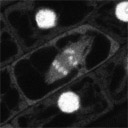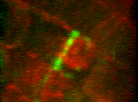| Polarized cytokinesis | ||||||
 |
||||||
| Confocal imaging of GFP markers allows us to image cells in their native developmental context and to visualize cell behavior in three dimensions. We used a variety of subcellular markers to identify and observe dividing cells in intact Arabidopsis seedlings. By contrast to the symmetrical view of cytokinesis commonly depicted in textbooks, we observed that development of the phragmoplast and cell plate in vacuolate cells is highly polarized with respect to the plane of division. Because the geometry of cytokinesis is related to the underlying molecular mechanisms, this polarized mode of cytokinesis has several mechanistic implications. | ||||||
| PNAS paper (PDF file) | ||||||
| Images and movies | ||||||
| Model | ||||||
| Implications | ||||||
| Visualizing chromosome segregation | ||||||
|
||||||
| Timelapse image series of tag M253 fluorescence in a mitotic root cell. The series begins at prophase, the chromosomes can be seen to line up on a plane at metaphase, and then to separate during anaphase. The number of distinct labeled bodies visualized is consistent with the number of Arabidopsis chromosomes (5). 3-4 of these chomosomes are typically visible on an single confocal plane. Neighboring interphase nuclei are seen as very bright spheres. These nuclei were overexposed slightly to more clearly image the chromosomal fluorescence in the dividing cell.
Note that the cytosolic fluorescence in the dividing cells is relatively higher than that seen in the neighboring cells, suggesting the possibility that some portion of the fusion protein formerly enclosed within the nuclear membrane is now free to diffuse throughout the cytosol. The image series was aquired at a single confocoal plane at 30 second intervals and is played back at 10 frames per second. |
||||||



